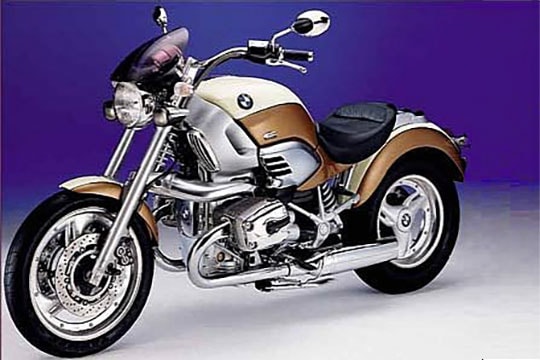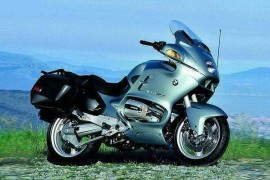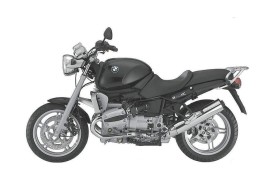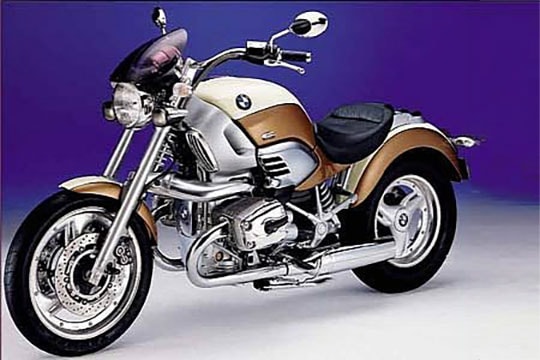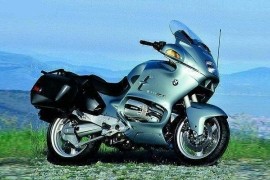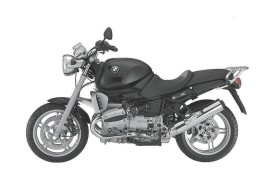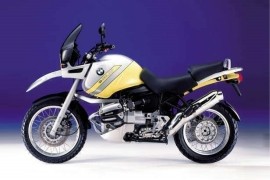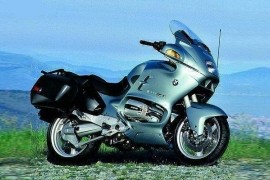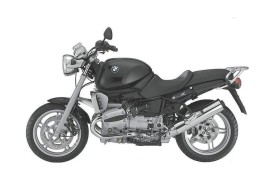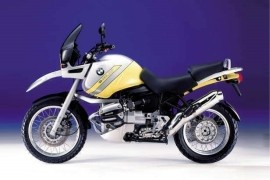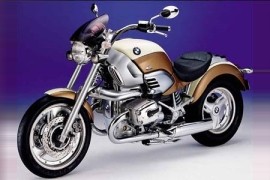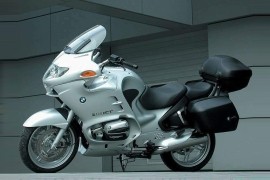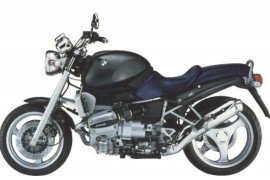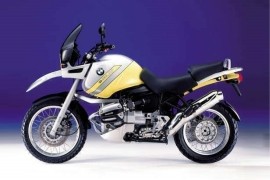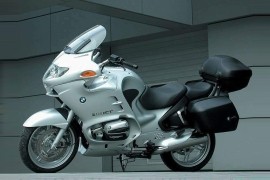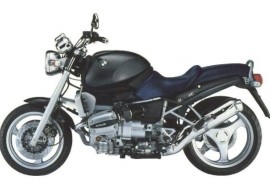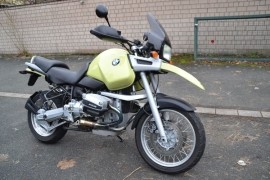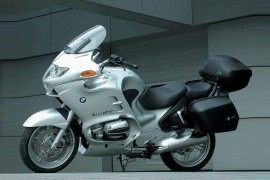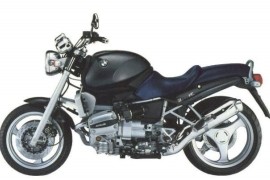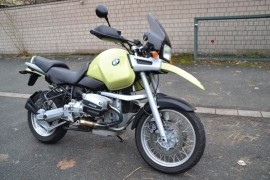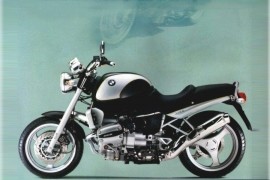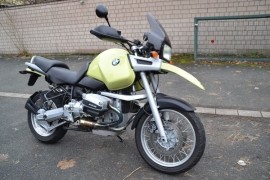BMW R 850 Models/Series Timeline, Specifications & Photos
First production year: 1995
In 2001, the German motorcycle released the BMW R 850 C, a cruiser motorcycle in its third and final production year. The bike suited those riders who wanted a modern cruiser with German reliability and one of the most unique designs from the House of Munich.
Despite the R 850 C and its larger sister being identical, with the only visual differences being the R 850 C badge on the fuel tank and the smaller engine, it never reached the same sales figures as its sister, so the R 850 C was removed from the product range in 2001.
The 2001 model came with the same package as the previous one, offering the same technical, visual, and performance specifications without any significant modifications whatsoever.
Aesthetically, the bike had standard features, such as a round headlight on the front, a small wind deflector, a single seat with a low seating position, a wide handlebar, two short exhausts with a silencer on each side, and three-spoke aluminum wheels.
The bike's suspension system comprised a BMW Motorrad Telelever system on the front and a BMW Motorrad system on the rear, delivering excellent suspension performance and handling.
In the performance department, the 2001 BMW R 850 C had its heartbeat set by an 848cc four-stroke twin-cylinder air/oil-cooled engine that delivered 50 hp at 5,250 rpm and 71 Nm (52 lb-ft) at 4,750 rpm.
After the R 1100 RT, the German motorcycle manufacturer introduced a smaller 850cc version in the form of the BMW R 850 RT. The bikes were practically similar, with the engine being the single exception.
The R 850 RT was a luxurious motorcycle with a large touring cockpit, an electrically adjustable windscreen, a digital fuel gauge, an oil temperature gauge, a clock, a gear indicator, a speedometer, and a tachometer. It also packed an ABS that could have been turned off.
In addition to its luxurious fittings, the bike had standard features such as a full fairing, a single headlight unit, a windscreen, a two-piece dual seat with passenger grab rails, a top case, side-mounted panniers, a side stand, and five-spoke aluminum alloy wheels.
The motorcycle was built around a three-section composite frame with a BMW Motorrad Telelever system on the front and a BMW Motorrad Paralever system on the rear, offering excellent suspension performance and handling.
In the performance department, the 2001 BMW R 850 RT had its soul brought to life by an 848cc four-stroke air/oil-cooled twin-cylinder boxer engine underneath its fuel tank, boasting 73 hp at 6,750 rpm and 77 Nm (57 lb-ft) torque at 5,600 rpm.
The bike's engine was coupled to a five-speed transmission that sent the power to the rear wheel via a final shaft drive, launching the motorcycle to a top speed of 186 kph (116 mph).
In 2001, the German motorcycle maker released the BMW R 850 R, a motorcycle in its seventh and final production year. In addition, the bike was produced again in 2004 as the R 850 R Comfort.
As with previous models, the 2001 R 850 R came in the same shape and form, offering the same technical, visual, and performance specifications without any significant modifications whatsoever.
The bike was created by German engineers for those riders who wanted a machine for both city traffic and weekend strolls. It was also a fuel-efficient motorcycle with the unmistakable feel and sound of a boxer engine.
Aesthetically, the motorcycle packed the same features as previous models, such as a round headlight with a chromed housing, a two-piece dual seat with passenger grab rails, a luggage rack, a two-into-one exhaust system, a single-sided swingarm, and five-spoke aluminum wheels.
As for the power figures, the 2001 BMW R 850 R took its muscles from an 848cc four-stroke air/oil-cooled twin-cylinder boxer engine that delivered an output power of 73 hp at 6,750 rpm and 77 Nm (57 lb-ft) torque at 5,600 rpm.
In the braking department, the motorcycle packed two 320 mm brake discs on the front coupled to four-piston calipers and a single 276 mm brake disc with a dual-piston caliper, delivering optimum stopping power.
The BMW R 850 C was the sister model of the larger R 1200 C version made from 1997. The R 850 C model debuted in 1999, and, contrary to tradition, the maker used a lot of chrome on this particular machine.
In 2000, the German motorcycle maker released the BMW R 850 C, a cruiser motorcycle in its second production year, delivering the same technical, visual, and performance specifications as the previous one without any changes.
In the visual department, the motorcycle packed standard fittings, such as a round headlight on the front, a small wind deflector, a single seat with a low seating position, a wide handlebar, two short exhausts with a silencer on each side, and three-spoke aluminum wheels.
Despite the R 850 C and its larger sister being identical, with the only visual differences being the R 850 C badge on the fuel tank and the smaller engine, it never reached the same sales figures as its sister, so the R 850 C was removed from the product range in 2001.
A BMW Motorrad Telelever system and two 305 mm brake discs tied to four-piston calipers controlled the front end. In comparison, the rear end was controlled by a BMW Motorrad Monolever system and a 285 mm disc with a dual-piston caliper.
As for power, the 2000 BMW R 850 C took its muscles from an 848cc four-stroke twin-cylinder air/oil-cooled engine that delivered 50 hp at 5,250 rpm and 71 Nm (52 lb-ft) at 4,750 rpm.
The BMW R 850 RT was a luxurious touring motorcycle made by BMW for those BMW fans who wanted to spend as much time as possible behind bars but also desired a fuel-efficient machine.
In 2000, the German motorcycle manufacturer released the BMW R 850 RT, a luxurious touring machine created by the House of Munich for those riders who wanted to spend as much time behind bars but also desired a fuel-efficient machine.
The 2000 model came with the same package as the previous one, delivering the same technical, visual, and performance specifications without any significant changes whatsoever.
As for the power figures, the 2000 BMW R 850 RT had its soul brought to life by an 848cc four-stroke air/oil-cooled twin-cylinder boxer engine hidden underneath its full fairing, delivering 73 hp at 6,750 rpm and 77 Nm (57 lb-ft) torque at 5,600 rpm.
The power generated by the engine was transferred to a five-speed manual gearbox controlled by a dry single-plate clutch, sending it to the rear end via a final shaft drive, pushing the motorcycle to a top speed of 186 kph (116 mph).
The R 850 RT was a luxurious motorcycle with a large touring cockpit, an electrically adjustable windscreen, a digital fuel gauge, an oil temperature gauge, a clock, a gear indicator, a speedometer, and a tachometer. It also packed an ABS that could have been turned off.
The BMW R 850 was a series of motorcycles manufactured by BMW in different forms with different designations. The series was powered by an air/oil-cooled two-cylinder boxer engine and was delivered in parallel with the heavier R 1100 and R 1150 models.
In 2000, the German motorcycle maker released the BMW R 850 R, a bare version of the R 850 series. It was in its sixth consecutive production year and came in the same shape and form as the previous ones without significant changes.
It was fitted with standard features in the visual department, such as a round headlight with a chromed housing, a two-piece dual seat with passenger grab rails, a luggage rack, a two-into-one exhaust system, a single-sided swingarm, and five-spoke aluminum wheels.
It was made around a three-section composite frame with a 35 mm BMW Motorrad Telelever fork on the front that offered 120 mm of travel and a die-cast single-sided aluminum swingarm with a BMW Motorrad Paralever system on the rear that offered 135 mm of travel.
As for stopping power, the motorcycle relied on two 320 mm brake discs on the front coupled to four-piston calipers and a single 276 mm brake disc with a dual-piston caliper, delivering optimum stopping power.
Power-wise, the 2000 BMW R 850 R had its heartbeat set by an 848cc four-stroke air/oil-cooled twin-cylinder boxer engine that boasted 73 hp at 6,750 rpm and 77 Nm (57 lb-ft) torque at 5,600 rpm.
The BMW R 850 GS was the smaller sister of the R1100GS, being in production as a cheaper alternative. The motorcycles were aesthetically and mechanically identical, the only differences being the tank badges and the engine.
In 2000, the German motorcycle maker released the BMW R 850 GS, a middle-class dual-sports motorcycle, in its fifth consecutive production year. It featured the same technical, cosmetic, and performance specifications as the previous one without any changes.
It was the smaller sister of the BMW R1100GS, a dual-sports motorcycle introduced in 1993 and produced from 1994 until 1999 in Berlin, Germany. The bike was superseded in 1999 by the R1150GS.
The R 850 GS was manufactured around a three-section composite frame. Its suspension system comprised a 35 mm BMW Motorrad Telelever system on the front that provided 120 mm of travel and a BMW Motorrad Paralever system on the rear with 135 mm wheel travel.
For stopping purposes, the motorcycle relied on two 305 mm brake discs on the front and a 276 mm brake disc on the rear. The front ones were tied to four-piston calipers, and the rear to a dual-piston caliper.
The 2000 BMW R 850 GS was powered by an 848cc four-stroke air/oil-cooled two-cylinder boxer engine mounted underneath its fuel tank, boasting 73 hp with a peak force at 6,750 rpm and 77 Nm (57 lb-ft) torque at 5,600 rpm.
In 1999, the German motorcycle manufacturer released the BMW R 850 RT, a luxurious touring motorcycle similar to the larger R 1100 RT, apart from the engine. The 1999 model came in the same shape and form as the previous one, featuring the same technical, visual, and performance specifications.
It came with standard fittings, such as a full fairing, a single headlight unit, a windscreen, a two-piece dual seat with passenger grab rails, a top case, side-mounted panniers, a side stand, and five-spoke aluminum alloy wheels.
Besides its standard features, the motorcycle had a large touring cockpit, an electrically adjustable windscreen, a digital fuel gauge, an oil temperature gauge, a clock, a gear indicator, a speedometer, and a tachometer. It also packed an ABS that could have been turned off.
The bike was made around a three-section composite frame with a BMW Motorrad Telelever system on the front and a BMW Motorrad Paralever system on the rear, offering excellent suspension performance and handling.
The braking power was achieved by two 320 mm brake rotors with four-piston calipers mounted on the front wheel and a 276 mm brake rotor with a dual-piston caliper mounted on the rear wheel.
As for power, the 1999 BMW R 850 RT had its heartbeat set by an 848cc four-stroke air/oil-cooled twin-cylinder boxer engine mounted underneath its fuel tank, boasting 73 hp at 6,750 rpm and 77 Nm (57 lb-ft) torque at 5,600 rpm.
In 1999, the German motorcycle maker released the BMW R 850 R, a motorcycle created by German engineers as a fuel-efficient and teamed version of their flagship R 1150 R naked model.
The 1999 motorcycle came with the same package as the previous one, delivering the same technical, visual, and performance specifications without any modifications whatsoever.
The BMW R 850 was a series of motorcycles made by BMW in different forms with different designations. The series was powered by an air/oil-cooled two-cylinder boxer engine and was delivered in parallel with the heavier R 1100 and R 1150 models.
In the visual department, the motorcycle packed standard fittings, like a round headlight with a chromed housing, a two-piece dual seat with a passenger grab handle, an up-swept exhaust system, a single-sided swingarm, and three-spoke aluminum wheels.
For suspension, the bike packed a 35 mm Motorrad Telelever system on the front with 120 mm of travel and a die-cast aluminum swingarm with a BMW Motorrad Paralever system on the rear with 135 mm of travel.
As for the stopping power, the bike packed two 320 mm brake discs on the front with four-piston calipers and a single 276 mm brake disc with a dual-piston caliper on the rear, offering optimum stopping power.
The 1999 BMW R 850 R was powered by an 848cc four-stroke air/oil-cooled two-cylinder boxer engine that delivered an output power of 73 hp with maximum strength at 6,750 rpm and 77 Nm (57 lb-ft) torque at 5,600 rpm.
In 1999, the German motorcycle manufacturer released the BMW R 850 GS, a dual-sports middle-class motorcycle that debuted in 1996 and continued production until 2001. It was the smaller-capacity sister model of the BMW R1150GS and was mechanically and cosmetically similar, with the only difference being the engine displacement.
The 1999 motorcycle came in the same shape and form as the previous one, delivering the same visual, technical, and performance specifications. It didn't feature any significant modifications whatsoever.
In the visual department, the bike had standard features, like a front mudguard mounted close to the wheel, a high-mounted front beak, a rectangular headlight, a small windscreen, a two-piece dual seat with a passenger grab handle, an up-swept exhaust system, a center stand, a single-sided swingarm, and wire-spoke wheels.
As for the power figures, the 1999 BMW R 850 GS had installed an 848cc four-stroke twin-cylinder air/oil-cooled boxer engine at its core, boasting 73 hp at 6,750 rpm and 77 Nm (57 lb-ft) torque at 5,600 rpm.
The R 850 GS was made around a three-section composite frame with a 35 mm BMW Motorrad Telelever system on the front that offered 120 mm of travel and a BMW Motorrad Paralever system on the rear with 135 mm of travel.
In the braking department, the bike relied on two 305 mm brake discs engaged by four-piston calipers on the front and a 276 mm brake rotor with a dual-piston caliper on the rear wheel, providing optimum stopping performance.
In 1999, BMW Motorrad presented the R 850 C as the little sister of the R 1200 C. The model was identical to its bigger sister in other departments, except for the 848cc engine borrowed from the R 850 R model.
The engineers tuned the engine to reduce the power output from 70 to 50 hp for a more favorable insurance rating.
The R 850 C and its larger sister shared the newly developed chassis, which had an extended wheelbase and a typical flat steering angle of the telescopic fork with the polished Telelever trailing arm.
Despite the R 850 C and its larger sister being identical, the only visual difference being the R 850 C's badge on the fuel tank, it never approached the sales figures as its sister, so the R 850 C was removed from the product range in 2001.
The 1999 BMW R 850 C was powered by an848cc four-stroke air/oil-cooled twin-cylinder boxer engine that delivered an output power of 50 hp at 5,250 rpm and 71 Nm (52 lb-ft) torque at 4,750 rpm, pushing the motorcycle to a top speed of 155 kph (95 mph).
The 1998 BMW R 850 C came with standard features such as dual 305 mm disc brakes on the front coupled to a single 285 mm rear disc, a two-piece dual seat, a chromed dual exhaust system, an analog instrumentation panel, pulled-back ape-hanger handlebars, wire-spoked wheels, and a wide rear tire.
The BMW R 850 RT was a luxurious touring motorcycle manufactured by BMW for those BMW fans who wanted to spend as much time as possible behind bars but also desired a fuel-efficient machine.
In 1998, the German motorcycle maker released the BMW R 850 RT, a touring machine that came with the same package as the previous one, delivering the same technical, performance, and visual specifications.
The luxurious motorcycle packed a large touring cockpit, an electrically adjustable windscreen, a digital fuel gauge, an oil temperature gauge, a clock, a gear indicator, a speedometer, and a tachometer. It also packed an ABS that could have been turned off.
It was fitted with standard features, such as a full fairing, a single headlight unit, a windscreen, a two-piece dual seat with passenger grab rails, a top case, side-mounted panniers, a side stand, and five-spoke aluminum alloy wheels.
All those features were bolted to a three-section composite frame with a BMW Motorrad Telelever system on the front that provided 120 mm of travel and a BMW Motorrad Paralever system on the rear, offering 135 mm of travel.
As for the power figures, the 1998 BMW R 850 RT boasted 73 hp at 6,750 rpm and 77 Nm (57 lb-ft) torque at 5,600 rpm, coming from an 848cc four-stroke air/oil-cooled twin-cylinder boxer engine hidden underneath its full fairing.
The BMW R 850 was a series of motorcycles produced by BMW in different forms with different designations. The series was powered by an air/oil-cooled two-cylinder boxer engine and was delivered in parallel with the heavier R 1100 and R 1150 models.
In 1998, the German motorcycle manufacturer released the BMW R 850 R, a bike in its fourth consecutive year of production. The 1998 model came with the same package as the previous one, without any changes.
In the performance department, the 1997 BMW R 850 R had installed an 848cc four-stroke air/oil-cooled two-cylinder boxer engine that delivered an output power of 73 hp with maximum strength at 6,750 rpm and 77 Nm (57 lb-ft) torque at 5,600 rpm.
The bike's suspension system comprised a 35 mm Motorrad Telelever system on the front with 120 mm of travel and a die-cast aluminum swingarm with a BMW Motorrad Paralever system on the rear with 135 mm of travel.
As for the braking power, the bike's wheels were equipped with two 320 mm brake discs on the front with four-piston calipers and a single 276 mm brake disc with a dual-piston caliper on the rear, offering optimum stopping power.
Aesthetically, the motorcycle packed standard features, such as a round headlight with a chromed housing, a two-piece dual seat with a passenger grab handle, an up-swept exhaust system, a single-sided swingarm, and three-spoke aluminum wheels.
The BMW R 850 GS was the smaller companion of the R1100GS, being in production as a cheaper alternative. The bikes were aesthetically and mechanically identical, the only differences being the tank badges and the engine.
In 1998, the German motorcycle manufacturer released the BMW R 850 GS, a dual-sports middle-class machine created by BMW for those riders who wanted to explore as much as possible, whether on or off-road.
The motorcycle was manufactured around a three-section composite frame with a 35 mm BMW Motorrad Telelever system on the front that provided 120 mm of travel and a BMW Motorrad Paralever system on the rear with 135 mm of travel.
The bike's wire-spoke wheels were fitted with two 305 mm brake rotors tied to four-piston calipers on the front and a 276 mm brake disc engaged by a dual-piston caliper on the rear wheel, offering optimum stopping performance.
As for power, the 1998 BMW R 850 GS had its soul brought to life by an 848cc four-stroke air/oil-cooled two-cylinder boxer engine mounted underneath the fuel tank, delivering 73 hp at 6,750 rpm and 77 Nm (57 lb-ft) torque at 5,600 rpm.
In the aesthetic department, the motorcycle had standard features, like a front mudguard mounted close to the wheel, a high-mounted front beak, a rectangular headlight, a small windscreen, a two-piece dual seat with a passenger grab handle, an up-swept exhaust system, a center stand, a single-sided swingarm, and wire-spoke wheels.
In 1997, the German motorcycle manufacturer released the BMW R 850 RT, a motorcycle similar to the larger R 1100 RT, apart from the engine. The R 850 RT touring motorcycle was created by German engineers for those riders who wanted to spend as much time as possible behind bars but also a fuel-efficient machine.
The 1997 motorcycle came with the same package as the previous model, offering the same technical, visual, and performance specifications without any significant modifications whatsoever.
It was a luxurious motorcycle with a large touring cockpit, an electrically adjustable windscreen, a digital fuel gauge, an oil temperature gauge, a clock, a gear indicator, a speedometer, and a tachometer. It also packed an ABS that could have been turned off.
Besides that, the bike had standard fittings, such as a full fairing, a single headlight unit, a windscreen, a two-piece dual seat with passenger grab rails, a top case, side-mounted panniers, a side stand, and five-spoke aluminum alloy wheels.
The 1997 BMW R 850 RT had installed an 848cc four-stroke air/oil-cooled twin-cylinder boxer engine underneath its fuel tank, boasting 73 hp at 6,750 rpm and 77 Nm (57 lb-ft) torque at 5,600 rpm.
The power generated by the engine was redirected to a five-speed gearbox that sent it to the rear axle via a final shaft drive, launching the motorcycle to a top speed of 186 kph (116 mph).
In 1997, the German motorcycle manufacturer released the BMW R 850 R, a naked motorcycle created by BMW for those riders who wanted a gritty machine but also a fuel-efficient motorcycle with the unmistakable feel and sound of a boxer engine.
The BMW R 850 was a series of motorcycles made by BMW in different forms with different designations. The series was powered by an air/oil-cooled two-cylinder boxer engine and was delivered in parallel with the heavier R 1100 and R 1150 models.
The 1997 model came in the same shape and form as the previous one, delivering the same technical, visual, and performance specifications without any significant modifications whatsoever.
In the power department, the 1997 BMW R 850 R had installed an 848cc four-stroke air/oil-cooled two-cylinder boxer engine that delivered an output power of 73 hp with maximum strength at 6,750 rpm and 77 Nm (57 lb-ft) torque at 5,600 rpm.
For suspension, the bike packed a 35 mm Motorrad Telelever stanchion on the front with 120 mm of travel and a die-cast aluminum swingarm with a BMW Motorrad Paralever system on the rear with 135 mm of travel.
As for the stopping power, the motorcycle's wheels were fitted with two 320 mm brake discs on the front with four-piston calipers and a single 276 mm brake disc with a dual-piston caliper on the rear, offering optimum stopping power.
In 1997, BMW released the R 850 GS, an unexpected addition to the GS family, after four years of the established best-selling travel enduro motorcycle, namely the R 1100 GS.
Except for the 848cc engine retained from the R 850R, the little GS motorcycle was identical to its bigger sister down to the last detail. For beginner riders that didn’t want to be satisfied with a single-cylinder enduro, the bike had the advantage of being available in a 34 hp version.
Unfortunately for BMW, the model did not achieve the same level of acceptance as the Roadster with the 848cc engine and missed sales targets set by the manufacturer, and was discontinued without replacement in December 2000.
The 1997 BMW R 850 GS had at its core an 848cc flat-twin engine with a power output of 70 hp at 7,000 rpm and 77 Nm (57 lb-ft) of torque with a peak at 5,600 rpm. With a curb weight of 243 kg (536 lbs) and a six-speed manual transmission, the model rolled to a top speed of 187 kph (115 mph).
Right from the factory, the bike came with standard features such as dual front disc brakes and a single disc in the rear, cross-spoked wheels, a dual seat, a pillion grab handle, a small luggage rack, a small windscreen, a chromed exhaust muffler, and an analog and digital instrument panel.
In 1996, the German motorcycle manufacturer launched the BMW R 850 RT, a touring machine created by the House of Munich for those BMW fans who wanted to spend as much time as possible behind bars but also a fuel-efficient machine.
The R 850 RT was a luxurious motorcycle with a large touring cockpit, an electrically adjustable windscreen, a digital fuel gauge, an oil temperature gauge, a clock, a gear indicator, a speedometer, and a tachometer. It also packed an ABS that could have been turned off.
Visually, the motorcycle packed standard features, such as a full fairing, a single headlight unit, a windscreen, a two-piece dual seat with passenger grab rails, a top case, side-mounted panniers, a side stand, and five-spoke aluminum alloy wheels.
Underneath its armor, the 1996 BMW R 850 RT had installed an 848cc four-stroke air/oil-cooled twin-cylinder boxer engine that delivered an output power of 73 hp at 6,750 rpm and 77 Nm (57 lb-ft) torque at 5,600 rpm.
The bike was made around a three-section composite frame with a BMW Motorrad Telelever system on the front and a BMW Motorrad Paralever system on the rear, offering excellent suspension performance and handling.
As for the braking power, the bike relied on two 320 mm brake rotors with four-piston calipers mounted on the front wheel and a 276 mm brake rotor with a dual-piston caliper mounted on the rear wheel.
The BMW R 850 was a series of motorcycles manufactured by BMW in different forms with different designations. The series was powered by an air/oil-cooled two-cylinder boxer engine and was delivered in parallel with the heavier R 1100 and R 1150 models.
In 1996, the German motorcycle maker released the BMW R 850 R, the bare model of the R 850 series. The bike debuted in 1995, six-mounted after the larger R 1100 R model. It was in its second production year and came in the same package as the previous model without any modifications.
The motorcycle packed standard fittings in the visual department, such as a round headlight with a chromed housing, a two-piece dual seat with a passenger grab handle, an up-swept exhaust system, a single-sided swingarm, and three-spoke aluminum wheels.
Suspension-wise, the bike packed a 35 mm Motorrad Telelever stanchion on the front with 120 mm of travel and a die-cast aluminum swingarm with a BMW Motorrad Paralever system on the rear with 135 mm of travel.
The braking performance was achieved by two 320 mm brake discs on the front with four-piston calipers and a single 276 mm brake disc with a dual-piston caliper on the rear, offering optimum stopping power.
As for power, the 1996 BMW R 850 R had its soul brought to life by an 848cc four-stroke air/oil-cooled two-cylinder boxer engine that delivered 73 hp at 6,750 rpm and 77 Nm (57 lb-ft) torque at 5,600 rpm.
In 1996, the German motorcycle manufacturer introduced the BMW R 850 GS, a middle-class all-road motorcycle created for those riders who wanted to explore as much as possible, whether on or off-road.
It was the smaller sister of the BMW R1100GS, a dual-sports motorcycle introduced in 1993 and produced from 1994 until 1999 in Berlin, Germany. The bike was superseded in 1999 by the R1150GS.
Visually, the motorcycle packed standard features, such as a front mudguard mounted close to the wheel, a high-mounted front beak, a rectangular headlight, a small windscreen, a two-piece dual seat with a passenger grab handle, an up-swept exhaust system, a center stand, a single-sided swingarm, and wire-spoke wheels.
The bike was built around a three-section composite frame with a 35 mm BMW Motorrad Telelever system on the front that offered 120 mm of travel and a BMW Motorrad Paralever system on the rear with 135 mm of travel.
As for the stopping power, the bike's wheels were fitted with two 305 mm brake discs coupled to four-piston calipers on the front and a 276 mm brake disc with a dual-piston caliper on the rear wheel, offering optimum stopping performance.
In the power department, the 1996 BMW R 850 GS had installed an 848cc four-stroke air/oil-cooled two-cylinder boxer engine underneath its fuel tank, boasting 73 hp at 6,750 rpm and 77 Nm (57 lb-ft) torque at 5,600 rpm.
In 1995, BMW launched the R 850 R, which was presented as the sister model to the R 1100 R, but compared to its bigger sister, the cylinder bore diameter was reduced, which led from 1,085cc to an 848cc displacement.
The capacity change also reduced the engine power output from 80 hp to 70 hp, but all technical features and other components were identical to those on the R 1100 R model.
The 1995 BMW R 850 R motorcycle was meant to be the successor to the R 80 that was used by the authorities to be the perfect model in the BMW range that fitted the returnees and in 34 hp version for holders of graded driving licenses.
The power came from the 848cc flat-twin engine with an output power of 70 hp at 7,000 rpm and 77 Nm (57 lb-ft) of torque at 5,600 rpm that combined with a curb weight of 235 kg (518 lbs), registered a top speed of 187 kph (115 mph).
The 10 hp decrease had quite an impact on the driving pleasure, and compared to 1100, the acceleration, torque, and top speed were slightly worse. However, the model was more consistent in power delivery and more relaxed to maneuver.
The naked bike came with standard features such as dual 305 mm front disc brakes and a single 276 mm disc on the rear, die-cast aluminum wheels, a spacious 21-liter (5.5-gallon) fuel tank, analog instrumentation dials, a round headlight, a dual seat, and pillion grab rails.
The 1996 MY BMW R 850 GS has, at its heart, an air/oil-cooled, four-stroke, 848cc, boxer twin cylinder powerhouse mated to a five-speed manual transmission and can reach a maximum power output of 73 horsepower and 77 Nm of torque.
In addition, it comes with a BMW Motorrad Telelever front suspension and a Paralever rear unit, dual front disc brakes and a single disc in the rear, cross-spoked wheels, a dual seat, a pillion grab handle, a small luggage rack, a small windscreen, a chromed exhaust muffler and an analogue and digital instrument panel.
